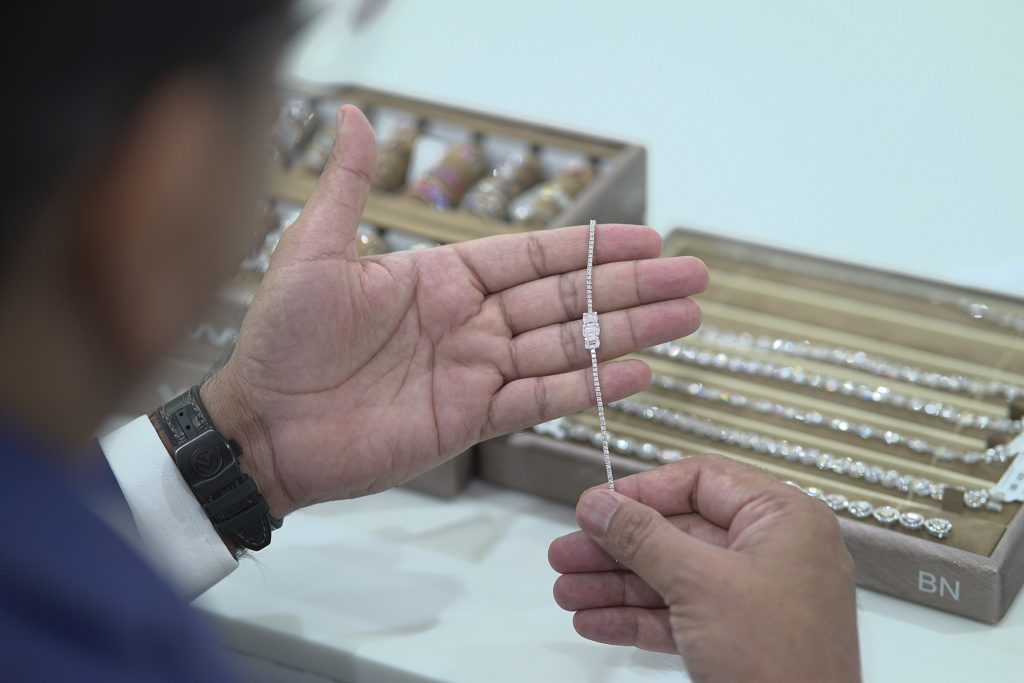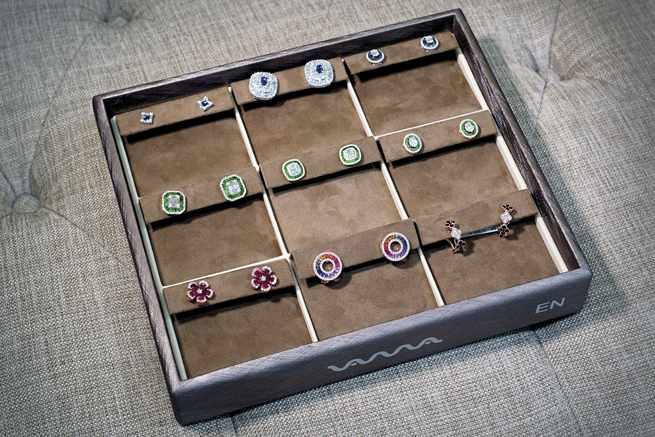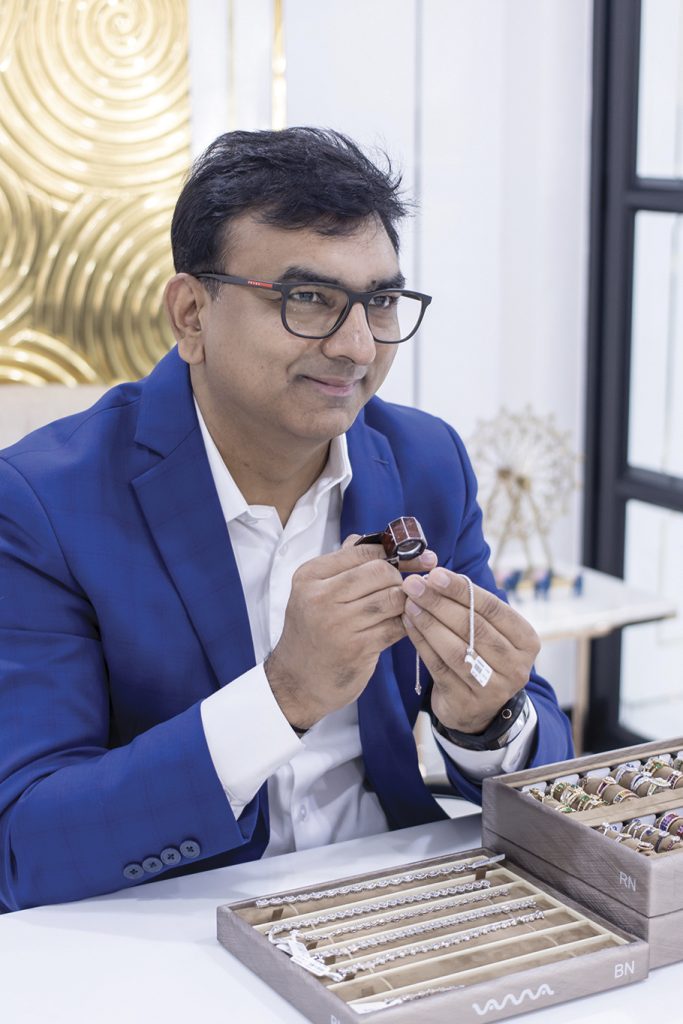Exquisite gems of innovation!
By Ayush Madan
Bhavesh Parmani is the man behind Vama Creation, a prestigious fine jewellery manufacturing company in Khlong San, Bangkok. Since 2003, they have been producing high quality rings, pendants, necklaces, earrings, and bracelets for daily wear.
Upon walking into the building, it started to feel like I was in the movie Uncut Gems (2019). The security guard at the desk buzzed me in and I took the elevator up to the fifth floor where Mr. Parmani and his son, Parth, welcomed me. His office was large and spacious, with white marble walls and inlaid gold accents. The entire aesthetic of the place gave me a feeling of purity. Both Mr. Parmani and Parth were dressed sharply, in tailor-fitted suits and polished loafers. When I asked to see the goods, Parth walked over to the vault and spun the wheel, pulling out a solid 7-inch thick steel door that looked impenetrable. He walked back to the table with several cases, laying out intricate designs of earrings and pendants in a myriad of different colors. Some pieces that stood out to me right away were the emerald studs, which had two rings of circular diamonds separated by a ring of emeralds. Even though my knowledge of jewellery was limited, it was clear to me that the quality and craftsmanship were both top-tier. Mr. Parmani tells Masala more about getting into the jewellery industry, and how he started his own business that just came into its 21st year.
Can you share a bit about your background and how you got started in jewellery making?
In 1990, when I lived in Mumbai, I started my journey of diamond grading at Shree Ramkrishna Exports at the age of 16. At the time, they were a small company, but today, they are a big name in the diamond business. By 1993, at age 19, I was entrusted with establishing the company’s office in Bangkok for diamond sales. Two years after that, my brother and I ventured into our own diamond-selling business, a journey that continued until 2002. In 2003, we decided to add value to diamonds, giving rise to our jewellery manufacturing company, Vama Creation. The shift from diamond sales to jewellery was motivated by the desire for creativity in an industry saturated with competition. Today, at Vama Creation, we take pride in our ability to create wonders in jewellery, fueled by an insatiable hunger for innovation. Needless to say, I have been in this industry for over two decades, and have no plans of departing from it anytime soon.
Your website emphasizes audacity and creativity. How do you continue to innovate jewellery design 21 years later?
Actually, jewellery is all about design and finishing. So, we keep adding new things into our businesses. Before, we were only doing diamond jewellery, but now we have added some colour into it, like ruby, sapphire, and emerald. These multi-gem designs are interesting for us, and also exciting for customers. We have a dedicated design team in-house which is constantly innovating and pushing new boundaries. This is why three times a year, when we launch a new collection, many of our clients are keen to see what new trends we will bring to the market. We have released Colorstone, Dream, Flower, Love Timeless, and our different shaped Illusion collections thus far.
How long does it take to create a new piece from design stage to completion?
It depends on the size of the piece, but generally it will take about 6 weeks. After the design phase, we use CAD (computer aided design) to create a 3D model of the jewellery. The second step is casting, when the piece starts coming to life. We make the first mold of the piece which takes time to get right, but once we do, we can make 50 to 100 of the same piece quickly and easily. After casting, the jewellery goes through a filing process where the structure of the piece is refined aesthetically. Once the mount is complete, the jewellery is ready for the fourth step which is stone setting. Diamonds and stones are hand-selected, meticulously colour matched and set, and forwarded to the in-house setters. Finally, the piece is polished and carefully checked for quality control before being delivered to the client. This year we have added a variety of colours and materials, including multi-sapphire rainbow, black and white diamonds, blue sapphire, pink sapphire, yellow sapphire, and natural rubies. We also incorporate different diamond cuts like step, round, marquise, and pear shapes.
What is your main method of customer outreach?
My son Parth and I travel to 15 to 20 jewellery exhibitions a year. These events are held all over the world in cities like Vicenza, Hong Kong, Las Vegas, New York City, Miami, Doha, and Manama. I can confidently say after 21 years we have been to almost every country in the world. Our customers come from countries we had not even heard from prior to meeting them, like our clients from Honduras who found us at a trade show. They came to our booth because they liked our product and then asked for the currency conversion. Even if they don’t buy anything the first time, they remember our brand, and their confidence in our product increases, leading to new and returning customers.
Why not use lab diamonds?
Lab diamonds are new in the jewellery industry. Some people don’t care whether their diamonds are natural or not. Take the US for example, they only care about fashion, not the value of the diamond. To them it’s more of a use and throw attitude, but of course, for Asian people we do think about the investment. This is why we did not even consider it. While lab diamonds are cheaper, your turnover will also go down, because their value is only 5 to 10 percent of the original. When your turnover is down, so is your profit.
What advice would you give to those entering the jewellery industry?
Patience is the key, because it takes some time to become established. You will learn a lot along the way. And of course, when precious items are involved, sometimes things go missing. You can’t do everything by yourself, so that risk is always there. For instance, at this facility we employ 120 people full-time. However, we have also learned along the way how to secure our product. Big doors, infrared cameras, and an on-site security team are some of our measures to prevent theft. When we leave the building, all the alarms are activated. If for any reason the alarm is tripped, we are notified immediately and so are the authorities. It is definitely not a small investment, but we have learned the hard way how important it is.









